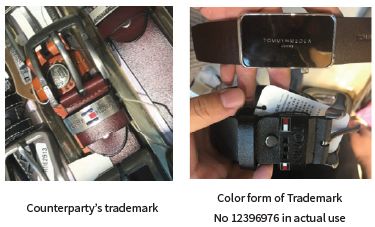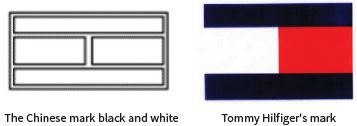It frequently happens to walk in a mall or just around the street to bump into a store logo that not-barely remind the most famous flag of Tommy Hilfiger (TH).
Maybe it's because it's becoming a trendy-trademark, maybe just because a flag is easy to copy. However, what is clear is that the brand owned by the Apparel Company PVH Corp's whose portfolio includes many famous brands, among which also Calvin Klein, is recently facing an increasing number of copycats.
When finding the common aspect of the copies, the infringers usually register a mark that bears some similarity to TH's lines of the device marks and deliberately altered the based part or coloring the device part to heighten the similarity.
This is what happened in a recent case the Beijing High Court came to learn.
A Chinese company started to use a trademark composed ![]() by girdles, no. 12396976 – registered
on goods "girdles (clothes)", which by itself
was not considered infringement, since the American Brand does not
have any protection for the mere girdles – but they suddenly
decided to fill the girdles up with the same color used in the
Tommy Hilfiger's Flag logo.
by girdles, no. 12396976 – registered
on goods "girdles (clothes)", which by itself
was not considered infringement, since the American Brand does not
have any protection for the mere girdles – but they suddenly
decided to fill the girdles up with the same color used in the
Tommy Hilfiger's Flag logo.

Immediately, Tommy Hilfiger filed an invalidation against the Chinese competitors before the Chinese Trademark Office (CNIPA).
For the American Brand, it was pretty clear that the two flags had to be considered similar marks on similar goods.
Specifically, even though the visual appearance of the disputed trademark and device seems distinguishable, when the black and white mark is colored with the same colors as Tommy Hilfiger's Flag, then the similarity becomes clear.

As legal ground, TH affirmed that the prior use of their mark should have been recognized as similar and therefore, as established by the article 30 of the Trademark law, which says Where a trademark [...] is identical with or similar to the trademark of another person that has, in respect of the same or similar goods, been registered or preliminarily approved, the Trademark Office shall refuse the application without announcement.
Moreover, the intentional choice of goods was a proof of bad faith since it was finalized to lower the possibility that the goods of the disputed mark being found similar to the key goods of TH's cited trademarks.
The Chinese registrant argued that the slight difference among the goods should have allow to distinguish the companies and therefore to avoid the misleading of the consumer and this argument seemed working before the CNIPA, which rejected the request on invalidation filed by Tommy Hilfiger.
However, the decision has been quickly overturned by the Beijing Court first and then by the Beijing High Court in the decision issued in 2020 which, on the contrary, recognized the violation of the articles 30 and 32 of the trademark law, stating that:
- Tommy Hilfiger's mark has a certain reputation on the clothes field in China;
- "Girdles (clothes)" shall be deemed as a similar item to "apparel";
- Tommy Hilfiger's mark had acquired certain influence on "girdles" through extensive use in China, and
- The Chinese company was in bad faith.
Following to the decision, on June 17, 2020, the CNIPA issued the "Criteria for Determination of Trademark Infringement", in which Article 24.1 provides that:
The registrant of a registered trademark without specifying any colors may color his/her trademark freely.
However, where the coloring aims to free-ride other's registered trademark in respect of same or similar goods/services so that the colored trademark is similar to the latter's registered trademark, thus is likely to cause confusion, it falls under the trademark infringement act as prescribed by Article 57.2 of the Trademark Law.

It is still not certain if the above reported issuance is a consequence of the Tommy Hilfiger case. What is certain is that Tommy Hilfiger will finally have the chance to lower more and more flags in the future.
The content of this article is intended to provide a general guide to the subject matter. Specialist advice should be sought about your specific circumstances.

